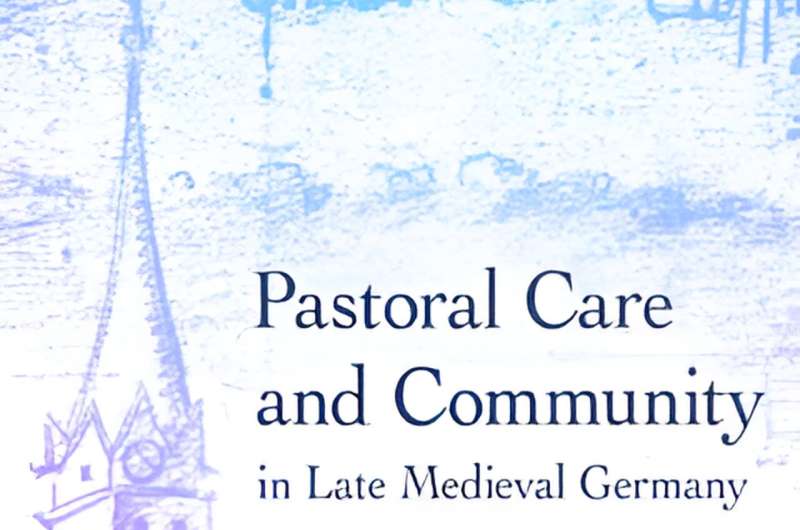This article has been reviewed according to Science X's editorial process and policies. Editors have highlighted the following attributes while ensuring the content's credibility:
fact-checked
trusted source
proofread
Demonic obsession: A different look at mental health in the medieval period

Demons today are characterized in horror movies like "The Ring," "The Conjuring," and "The Exorcist" as paranormal entities—supernaturally powerful beings, with little relevance in reality. But in the medieval period, demons were ever-present. Specifically in medieval Europe, demons bedeviled communities, shocked religious leaders, and puzzled doctors.
Associate Professor of Religion and History Deeana Klepper, a self-described medievalist, studies these "demonic obsessions." She gained interest in the subject after parsing through a large manuscript in the Bavarian State Library in Munich during the summer of 2015.
When she initially stumbled upon demonic obsession rhetoric, Klepper was doing research for her second book on European medieval religious culture, "Pastoral Care and Community in Late Medieval Germany: Albert of Diessen's 'Mirror of Priests,'" which focuses on a Latin manual for German parish priests written by Augustinian canon Albert from Bavaria in the 1370s.
The Munich manuscript alluded to an attack on a person's psyche from the outside—a "demonic obsession," as opposed to "demonic possession." This surprised Klepper.
"Most of us know about possession of humans by demons from pop culture, but the author didn't only use the term 'possession,' he also used the term 'obsession,' which is to be tortured or tormented or harmed in some way without the demon taking over the person's being," Klepper said.
In possession, the demon inhabited the victim, while in obsession the demon did not. Through the 13th century, behaviors we might associate with mental illness were often thought to be caused by demonic possession. But by the later 14th century, people began to avoid religious explanations for mental illnesses; instead, they spoke in medical terms about imbalances of the four humors in the human body as the cause of mental illness.
Those who did still see a spiritual source to such suffering began to speak in terms of "obsession" rather than "possession," Klepper explained. This might have allowed for "a more compassionate response to the mentally ill," which would have been less terrifying to the individual's neighbors, she said.
In fact, Albert seemed more compassionate about people's mental health than others in the region, Klepper said. In the Munich manuscript, Albert asserted that those who "take their own life in the throes of that experience of demonic harassment"—demonic obsession—deserved to be buried with their loved ones, even though that was usually forbidden.
Albert's perspective was unique during the time, Klepper said, as during the same time period, some European city governments banished people who exhibited signs of mental illness. Klepper questioned how to reconcile these two opposing realities: harsh banishments versus increased sympathy for those who suffered from demonic obsession.
To research this, Klepper traveled to Bologna, Italy in 2022. She searched libraries at the city's university, which houses one of the oldest medical schools and one of the most prominent law schools that teaches Christian Canon Law and secular law, for records of demonic obsession. When she found nothing, she headed to Germany to see if there were any relevant manuscripts there, and she has also searched at the Huntington Library in California and the Bodleian Library in Oxford.
"The problem with being a medievalist who works with manuscripts is you get some ideas about where you might find a discussion in books from the 13th, 14th, 15th century, but they're not searchable," she said. "You say to yourself, 'where's the most likely spot where people might have been having conversations about x, or where I might find x?'… it's a little bit of a needle in a haystack thing."
Two years into her research project, the next step for Klepper is to spend more time looking at vernacular texts and advice manuals for priests for additional mentions of demons. Eventually, she hopes to write a book for both an academic and general audience on demonic obsession and mental illness and its perception through history.
"This book would explicitly make the connections between this medieval phenomenon that I'm noting and its sort of fear, compassion, and peace, and trace it into the modern, making connections with our own world," said Klepper.
More information: Pastoral Care and Community in Late Medieval Germany: Albert of Diessen's 'Mirror of Priests. www.cornellpress.cornell.edu/b … -germany/#bookTabs=1
Provided by Boston University




















